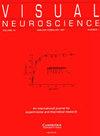小鼠背侧膝状核的组织结构
IF 2.3
4区 医学
Q4 NEUROSCIENCES
引用次数: 0
摘要
丘脑背侧膝状核(dLGN)是视觉信息从视网膜传递到视觉皮层的主要通道。最初,人们将其视为一个简单的中继器,但最近对小鼠的研究揭示了来自视网膜的输入在 dLGN 中的组合、传输和处理方式要复杂得多。在这里,我们通过研究视网膜投射到 dLGN 的模式,以及它们如何汇聚到丘脑皮层神经元,从而形成流向视觉皮层的视觉信息,来探讨小鼠视网膜原视通路的结构和功能组织。本文章由计算机程序翻译,如有差异,请以英文原文为准。


Organization of the dorsal lateral geniculate nucleus in the mouse.
The dorsal lateral geniculate nucleus (dLGN) of the thalamus is the principal conduit for visual information from retina to visual cortex. Viewed initially as a simple relay, recent studies in the mouse reveal far greater complexity in the way input from the retina is combined, transmitted, and processed in dLGN. Here we consider the structural and functional organization of the mouse retinogeniculate pathway by examining the patterns of retinal projections to dLGN and how they converge onto thalamocortical neurons to shape the flow of visual information to visual cortex.
求助全文
通过发布文献求助,成功后即可免费获取论文全文。
去求助
来源期刊

Visual Neuroscience
医学-神经科学
CiteScore
2.20
自引率
5.30%
发文量
8
审稿时长
>12 weeks
期刊介绍:
Visual Neuroscience is an international journal devoted to the publication of experimental and theoretical research on biological mechanisms of vision. A major goal of publication is to bring together in one journal a broad range of studies that reflect the diversity and originality of all aspects of neuroscience research relating to the visual system. Contributions may address molecular, cellular or systems-level processes in either vertebrate or invertebrate species. The journal publishes work based on a wide range of technical approaches, including molecular genetics, anatomy, physiology, psychophysics and imaging, and utilizing comparative, developmental, theoretical or computational approaches to understand the biology of vision and visuo-motor control. The journal also publishes research seeking to understand disorders of the visual system and strategies for restoring vision. Studies based exclusively on clinical, psychophysiological or behavioral data are welcomed, provided that they address questions concerning neural mechanisms of vision or provide insight into visual dysfunction.
 求助内容:
求助内容: 应助结果提醒方式:
应助结果提醒方式:


